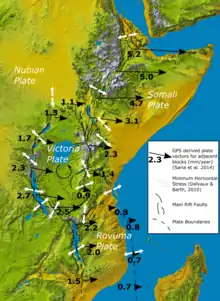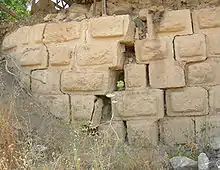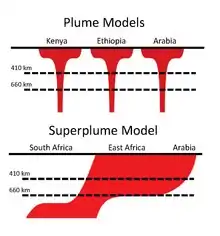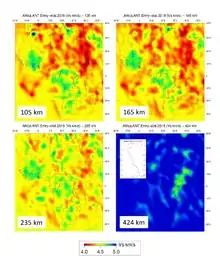East African Rift
The East African Rift (EAR) or East African Rift System (EARS) is an active continental rift zone in East Africa. The EAR began developing around the onset of the Miocene, 22–25 million years ago.[1] In the past it was considered to be part of a larger Great Rift Valley that extended north to Asia Minor.


A narrow zone, the rift is a developing divergent tectonic plate boundary where the African Plate is in the process of splitting into two tectonic plates, called the Somali Plate and the Nubian Plate, at a rate of 6-7 mm per year.[2] The rift system consists of three microplates, the Victoria Microplate to the north, and the Rovuma and Lwandle microplates to the south. The Victoria Microplate is rotating counter-clockwise with respect to the African plate. Its rotation is caused by the configuration of mechanically weaker and stronger lithospheric regions in the EARS.[3][4]
Extent

A series of distinct rift basins, the East African Rift System extends over thousands of kilometers.[5] The EAR consists of two main branches. The Eastern Rift Valley (also known as Gregory Rift) includes the Main Ethiopian Rift, running eastward from the Afar Triple Junction, which continues south as the Kenyan Rift Valley.[6] The Western Rift Valley includes the Albertine Rift, and farther south, the valley of Lake Malawi. To the north of the Afar Triple Junction, the rift follows one of two paths: west to the Red Sea Rift or east to the Aden Ridge in the Gulf of Aden.
The EAR runs from the Afar Triple Junction in the Afar Triangle of Ethiopia through eastern Africa, terminating in Mozambique.[7] The EAR transects through Ethiopia, Kenya, Congo DR, Uganda, Rwanda, Burundi, Zambia, Tanzania, Malawi and Mozambique. It also runs offshore of the coast of Mozambique along the Kerimba and Lacerda grabens, which are joined by the Davie Ridge, a 2,200 km-long (1,400 mi) relic fracture zone that cuts across the West Somali basin, straddling the boundary between Tanzania and Mozambique.[6] The Davie Ridge ranges between 30–120 km (19–75 mi) wide, with a west-facing scarp (east-plunging arch) along the southern half of its length that rises to 2,300 m (7,500 ft) above the sea floor.[6][8] Its movement is concurrent with the EAR.[9]
Competing theories on geologic evolution
Over time, many theories have tried to clarify the evolution of the East African Rift. In 1972 it was proposed that the EAR was not caused by tectonic activity, but rather by differences in crustal density. Since the 1990s, evidence has been found in favor of mantle plumes beneath the EAR.[10] Others proposed an African superplume causing mantle deformation.[11][12][13] Although the effects of deep-rooted mantle plumes are an important hypothesis, their location and dynamics are poorly understood, and a matter of active research.[14] The question is still debated.


The most recent and accepted view is the theory put forth in 2009: that magmatism and plate tectonics have a feedback with one another, controlled by oblique rifting conditions. According to this theory, lithospheric thinning generates volcanic activity, further increasing magmatic processes such as intrusions and numerous small plumes. These processes further thin the lithosphere in saturated areas, making the thinning lithosphere behave like a mid-ocean ridge.[12] According to marine geologist Kathleen Crane, the rift could eventually cause eastern Africa to separate from the mainland, although this potential event could take tens of millions of years.[16]
Studies that contribute to the broader understanding on the evolution of rifts can be grouped into the techniques of isotope geochemistry, seismic tomography and geodynamical modeling.
Isotope geochemistry
The varying geochemical signatures of a suite of Ethiopian lavas suggest multiple plume sources: at least one of deep mantle origin, and one from within the subcontinental lithosphere.[17] In accordance, a 2014 study 2014 compares the geochemical signature of rare earth isotopes from xenoliths and lava samples collected in the EAR. The results corroborate the coexistence of a superplume “common to the entire rift” with another mantle material source being either of subcontinental type or of mid-ocean ridge type.[18]
Seismic tomography
The geophysical method of seismic tomography is a suitable tool to investigate Earth's subsurface structures deeper than the crust. It is an inverse problem technique that models which are the velocities of the inner Earth that reproduce the seismographic data recorded all around the world. Recent improvements of tomographic Earth models of P-wave and S-wave velocities suggest that a superplume upwelling from the lower mantle at the northeastern EAR feeds plumes of smaller scale into the upper mantle.[19][20]
Geodynamical modeling
Parallel to geological and geophysical measures (e.g. isotope ratios and seismic velocities) it is constructive to test hypotheses on computer based geodynamical models. A 3D numerical geodynamic model of the plume-crust coupling was capable of reproducing the lateral asymmetry of the EAR around the Tanzania craton.[21] Numerical modeling of plume-induced continental break-up shows two distinct stages, crustal rifting followed by lithospheric breakup, and the upwelling between stages of an upper mantle plume.[22]
Geologic evolution
Prior to rifting, enormous continental flood basalts erupted on the surface and uplift of the Ethiopian, Somali, and East African plateaus occurred. The first stage of rifting of the EAR is characterized by rift localization and magmatism along the entire rift zone. Periods of extension alternated with times of relative inactivity. There was also the reactivation of a pre-Cambrian weakness in the crust, a suture zone of multiple cratons, displacement along large boundary faults, and the development of deep asymmetric basins.[5] The second stage of rifting is characterized by the deactivation of large boundary faults, the development of internal fault segments, and the concentration of magmatic activity towards the rifts.
Today, the narrow rift segments of the East African Rift system form zones of localized strain. These rifts are the result of the actions of numerous normal faults which are typical of all tectonic rift zones. As aforementioned, voluminous magmatism and continental flood basalts characterize some of the rift segments, while other segments, such as the Western branch, have only very small volumes of volcanic rock.[14]
Petrology
.jpg.webp)
The African continental crust is generally cool and strong. Many cratons are found throughout the EAR, such as the Tanzania and Kaapvaal cratons. The cratons are thick, and have survived for billions of years with little tectonic activity. They are characterized by greenstone belts, tonalites, and other high-grade metamorphic lithologies. The cratons are of significant importance in terms of mineral resources, with major deposits of gold, antimony, iron, chromium and nickel.[23]
A large volume of continental flood basalts erupted during the Oligocene, with the majority of the volcanism coinciding with the opening of the Red Sea and the Gulf of Aden approximately 30 Ma.[11][14] The composition of the volcanics are a continuum of ultra-alkaline to tholeiitic and felsic rocks. It has been suggested that the diversity of the compositions could be partially explained by different mantle source regions. The EAR also cuts through old sedimentary rocks deposited in ancient basins.[24]
Volcanism and seismicity
The East African Rift Zone includes a number of active and dormant volcanoes, among them: Mount Kilimanjaro, Mount Kenya, Mount Longonot, Menengai Crater, Mount Karisimbi, Mount Nyiragongo, Mount Meru and Mount Elgon, as well as the Crater Highlands in Tanzania. Although most of these mountains lie outside of the rift valley, the EAR created them.[24]
Notable active examples of EAR volcanism include Erta Ale, Dalaffilla (also called Gabuli, Alu-Dalafilla), and Ol Doinyo Lengai. Erta Ale is a basaltic shield volcano in the Afar Region of northeastern Ethiopia, continuously active since at least 1967,[25] with a summit lava lake documented since at least 1906.[26] The 2008 eruption of Dalafilla, its only documented activity since the start of the Holocene,[27] is the largest recorded eruption in Ethiopian history. Ol Doinyo Lengai is currently the only active natrocarbonatite volcano on Earth.[28] Its magma contains almost no silica; typical lava flows have viscosities of less than 100 Pa s,[29] comparable to olive oil at 26 °C. EAR-related volcanic structures with dated activity since the onset of the Holocene include approximately 50 in Ethiopia,[5] 17 in Kenya, and 9 in Tanzania.
The EAR is the largest seismically active rift system on Earth today. The majority of earthquakes occur near the Afar Depression, with the largest typically occurring along or near major border faults.[14] Seismic events in the past century are estimated to have reached a maximum moment magnitude of 7.0. The seismicity trends parallel to the rift system, with a shallow focal depth of 12–15 km (7.5–9.3 mi) beneath the rift axis. Further away from the rift axis, focal depths can be below 30 km (19 mi).[14][30] Focal mechanism solutions strike NE and frequently demonstrate normal dip-slip faulting, although left-lateral motion is also observed.[5]
Discoveries in human evolution
The Rift Valley in East Africa has been a rich source of hominid fossils that allow the study of human evolution.[5][31] The rapidly eroding highlands quickly filled the valley with sediments, creating a favorable environment for the preservation of remains. The bones of several hominid ancestors of modern humans have been found here, including those of "Lucy", a partial australopithecine skeleton discovered by anthropologist Donald Johanson dating back over 3 million years. Richard and Mary Leakey have also done significant work in this region.[32] In 2008, two other hominid ancestors have been discovered here: a 10-million-year-old ape called Chororapithecus abyssinicus, found in the Afar rift in eastern Ethiopia, and Nakalipithecus nakayamai, which is also 10 million years old.[33]
See also
- Baikal Rift Zone
- Lake Victoria
- Northern Cordilleran Volcanic Province
- West Antarctic Rift System
- West and Central African Rift System
References
- Ebinger, Cynthia (April 2005). "Continental break-up: The East African perspective". Astronomy and Geophysics. 46 (2): 2.16–2.21. doi:10.1111/j.1468-4004.2005.46216.x.
- Fernandes, R.M.S.; Ambrosius, B.A.C.; Noomen, R.; Bastos, L.; Combrinck, L.; Miranda, J.M.; Spakman, W. (2004). "Angular velocities of Nubia and Somalia from continuous GPS data: implications on present-day relative kinematics". Earth and Planetary Science Letters. 222 (1): 197–208. Bibcode:2004E&PSL.222..197F. doi:10.1016/j.epsl.2004.02.008.
- Osborne, Hannah (June 9, 2020) "One of Africa's Tectonic Plates Is Rotating in a Different Direction to All the Others" Newsweek
- GFZ GeoForschungsZentrum Potsdam, Helmholtz Centre (June 8, 2020) "Why the Victoria Plate in Africa rotates" Science Daily
- Corti, G. "The Ethiopian Rift Valley". National Research Council of Italy, Institute of Geosciences and Earth Resources. Retrieved March 19, 2014.
- Mougenot, D.; Recq, M.; Virlogeux, P.; Lepvrier, C. (June 1986). "Seaward extension of the East African Rift". Nature. 321 (6070): 599–603. Bibcode:1986Natur.321..599M. doi:10.1038/321599a0. S2CID 4282682.
- Chorowicz, Jean (2005). "The East African rift system". Journal of African Earth Sciences. 43 (1): 379–410. Bibcode:2005JAfES..43..379C. doi:10.1016/j.jafrearsci.2005.07.019.
- Mascle, J; Moungenot, D.; Blarez, E.; Marinho, M.; Virlogeux, P. (1987). "African transform continental margins: examples from Guinea, the Ivory Coast and Mozambique". Geological Journal. 2. 22: 537–561. doi:10.1002/gj.3350220632.
- Scrutton, R.A. (1978). "Davie fracture zone and the movement of Madagascar". Earth and Planetary Science Letters. 39 (1): 84–88. Bibcode:1978E&PSL..39...84S. doi:10.1016/0012-821x(78)90143-7.
- Montelli, R.G.; et al. (2006). "A catalogue of deep mantle plumes: New results from finite‐frequency tomography". Geochem. Geophys. Geosyst. 7 (11): n/a. Bibcode:2006GGG.....711007M. doi:10.1029/2006GC001248.
- Ebinger, C. J.; Sleep, N. H. (October 1998). "Cenozoic magmatism throughout east Africa resulting from impact of a single plume". Nature. 395 (6704): 788–791. Bibcode:1998Natur.395..788E. doi:10.1038/27417. S2CID 4379613.
- Corti, Giacomo (September 2009). "Continental rift evolution: From rift initiation to incipient break-up in the Main Ethiopian Rift, East Africa". Earth-Science Reviews. 96 (1–2): 1–53. Bibcode:2009ESRv...96....1C. doi:10.1016/j.earscirev.2009.06.005.
- Hansen, Samantha E.; Nyblade, Andrew A.; Benoit, Margaret H. (February 2012). "Mantle structure beneath Africa and Arabia from adaptively parameterized P-wave tomography: Implications for the origin of Cenozoic Afro-Arabian tectonism". Earth and Planetary Science Letters. 319–320: 23–34. Bibcode:2012E&PSL.319...23H. doi:10.1016/j.epsl.2011.12.023.
- Kearey, Philip; Klepeis, Keith A.; Vine, F.J. (2009). Global Tectonics. John Wiley & Sons. ISBN 978-1-4051-0777-8.
- Trabant, C.; Hutko, A. R.; Bahavar, M.; Karstens, R.; Ahern, T.; Aster, R. (6 September 2012). "Data Products at the IRIS DMC: Stepping Stones for Research and Other Applications". Seismological Research Letters. 83 (5): 846–854. doi:10.1785/0220120032.
- Gray, William R. (1983). Nature's World of Wonders. Washington, D.C.: National Geographic Society. p. 16. ISBN 978-2-09-290310-0.
- Furman, Tanya (June 2007). "Geochemistry of East African Rift basalts: An overview". Journal of African Earth Sciences. 48 (2–3): 147–160. Bibcode:2007JAfES..48..147F. doi:10.1016/j.jafrearsci.2006.06.009.
- Halldórsson, Saemundur A.; Hilton, David R.; Scarsi, Paolo; Abebe, Tsegaye; Hopp, Jens (16 April 2014). "A common mantle plume source beneath the entire East African Rift System revealed by coupled helium-neon systematics". Geophysical Research Letters. 41 (7): 2304–2311. Bibcode:2014GeoRL..41.2304H. doi:10.1002/2014GL059424.
- Civiero, Chiara; Hammond, James O. S.; Goes, Saskia; Fishwick, Stewart; Ahmed, Abdulhakim; Ayele, Atalay; Doubre, Cecile; Goitom, Berhe; Keir, Derek; Kendall, J.-Michael; Leroy, Sylvie; Ogubazghi, Ghebrebrhan; Rümpker, Georg; Stuart, Graham W. (September 2015). "Multiple mantle upwellings in the transition zone beneath the northern East-African Rift system from relative P-wave travel-time tomography". Geochemistry, Geophysics, Geosystems. 16 (9): 2949–2968. Bibcode:2015GGG....16.2949C. doi:10.1002/2015GC005948.
- Emry, E. L.; Shen, Y.; Nyblade, A. A.; Flinders, A.; Bao, X. (2019). "Upper mantle earth structure in Africa from full‐wave ambient noise tomography". Geochemistry, Geophysics, Geosystems. 20 (1): 120–147. Bibcode:2019GGG....20..120E. doi:10.1029/2018GC007804.
- Koptev, Alexander; Burov, Evgueni; Calais, Eric; Leroy, Sylvie; Gerya, Taras; Guillou-Frottier, Laurent; Cloetingh, Sierd (March 2016). "Contrasted continental rifting via plume-craton interaction: Applications to Central East African Rift". Geoscience Frontiers. 7 (2): 221–236. doi:10.1016/j.gsf.2015.11.002.
- Koptev, Alexander; Burov, Evgueni; Gerya, Taras; Le Pourhiet, Laetitia; Leroy, Sylvie; Calais, Eric; Jolivet, Laurent (October 2018). "Plume-induced continental rifting and break-up in ultra-slow extension context: Insights from 3D numerical modeling" (PDF). Tectonophysics. 746: 121–137. Bibcode:2018Tectp.746..121K. doi:10.1016/j.tecto.2017.03.025. S2CID 132400572.
- Taylor, C.D.; Schulz, K.J.; Doebrich, J.L.; Orris, G.J.; Denning, P.D.; Kirschbaum, M.J. "Geology and Nonfuel Mineral Deposits of Africa and Middle East". US Department of the Interior, US Geological Survey.
- Saemundsson, K (2009). "East African Rift System-An Overview". Reykjavik: United Nations University, Iceland GeoSurvey.
- Oppenheimer, C.; Francis, P. (1996). "Remote sensing of heat, lava and fumarole emissions from Erta 'Ale volcano, Ethiopia". Int. J. Remote Sens. 8: 1661–1692.
- Dainelli, G.; Marinelli, O. (1906). "Dell'Erta-ale, vulcano ritenuto attivo della Dancalia settentrionale". Rivista Geografica Italiana. 13: 261–270.
- "Alu-Dalafilla". Global Volcanism Program. Smithsonian Institution. Retrieved 2021-07-15.
- "Ol Doinyo Lengai". Global Volcanism Program. Smithsonian Institution. Retrieved 2021-07-15.
- Kervyn, Matthieu; Ernst, Gerald G. J.; Klaudius, Jurgis; Keller, Jörg; Kervyn, François; Mattson, Hannes B.; Belton, Frederic; Mbede, Evelyne; Jacobs, Patric (2008). "Voluminous lava flows at Oldoinyo Lengai in 2006: chronology of events and insights into the shallow magmatic system". Bull Volcanol. 70 (9): 1069–1086. Bibcode:2008BVol...70.1069K. doi:10.1007/s00445-007-0190-x. hdl:1854/LU-430096. S2CID 46977110.
- Siebert, L.; Simkin, T.; Kimberly, P. (2010). Volcanoes of the World. University of California Press.
- "Great Rift Valley Ecosystem – UNESCO World Heritage Centre". UNESCO. Retrieved March 14, 2008.
- Gibbons, A. (2002). "Profile: Michel Brunet: One Scientist's Quest for the Origin of Our Species". Science. 298 (5599): 1708–1711. doi:10.1126/science.298.5599.1708. PMID 12459568. S2CID 26316640.
- Seward, Liz (2007). "Fossils belong to new great ape". BBC News London. Retrieved March 14, 2008.